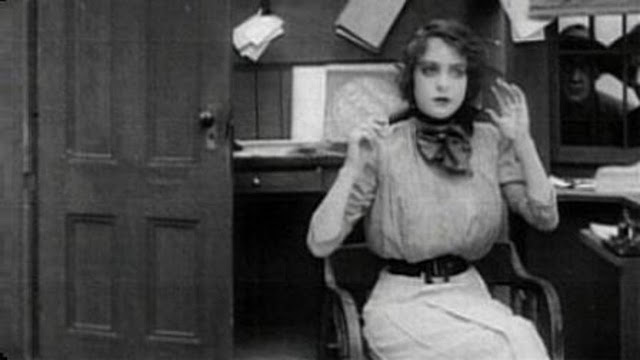April 6, 1913 [The Girl and Her Trust]
More explorations of the theme of "trust" from Griffith. Of course, a staple of the melodrama: the duty accepted and fulfilled. On the page and stage (and in the nickelodeon), this code of fidelity remains unbroken. And while I may question the realism of all those steadfast Negroes, from Uncle Tom to Griffith's George accepting and fulfilling "Their Trusts," the efforts of such characters is nothing short of astonishing.
The entrusted Grace, the telegraph operator, is played with unassuming naturalness by Dorothy Bernard, dismissive of the sarsaparilla-offering bumpkin, indulgent of the trainmen she has to deal with, affectionate but not insipid with her suitor—and most of all, diligent, able to hold her own—and keep her head, as danger explodes on the scene when the desperate robber-tramps descend. Griffith once more displays the effect of shifting perspectives, as the camera shows us first the telegraph office, then the action outside—then the two coming together as the robbers peer in—and we are inside, watching them from within. They force their way into the station, she locks them in the outer room, frantically telegraphs for help, the payroll locked away, the key entrusted to her. The plucky girl is grossly underestimated: She plugs the keyhole with a bullet, jams in a pair of scissors and strikes it with a hammer to shoot at the tramps! The pair wisely decide to take the express box and escape on a handcar, rather than hazard that resourceful young woman—but to no avail. She springs on them—they beat her, but she will not yield her hold—and of course The Chase ensues, an entire train at their heels—the camera following right along, the speed captured perfectly—and then we're on board with the frantic engineer. The train overtakes them, the robbers are shot—the girl right at their side, but unscathed.
And the ending is the most remarkable thing: The girl and her beau, seated on the cow-catcher, the rescued express box between them as a luncheon-table on which they rest their sandwiches, the girl not swooning from fright but thrilled by her adventure, her face animated as she regales her companion with her tale, pleased with herself as the train backs away.
And while I once more doubt the verisimilitude of such shenanigans, I cannot deny the combined natural and frenetic qualities of this breathless picture. The sense of speed and distance, the rapid jumps from scene to scene—again, that thrill of simultaneity—combine to force this absurd situation into—if not a recognizable reality, then one we readily accept, for fifteen full-tilt minutes.



Comments
Post a Comment